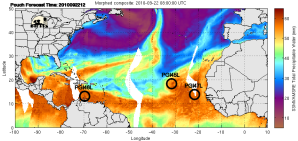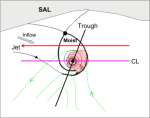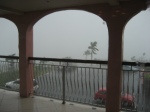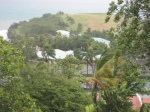PREDICT continued its string of successful research flights during week four by conducting unprecedented multiple missions in the early stages of developing storms. Excellent guidance from the investigators on storm timing and flight track placement produced ideal sampling locations for Earth Observing Laboratory (EOL) dropsondes, which have performed nearly flawlessly during PREDICT. Although there was only one occasion during which there was a need for two consecutive missions in one day, the NSF/NCAR Gulfstream V (GV) flew all but one day last week, using an additional 36.5 hours out of the 200 hours allocated and leaving approximately 90 hours remaining. This period of intensive operations was possible in part due to the period of double crewing, which now has just a few days remaining. As expected, the marine environment and cold temperatures have proven challenging for some of the aircraft instrumentation, requiring additional attention from the RAF technicians and mechanics, but the primary instrumentation for the project remains viable. The NSF/NCAR GV aircraft has been extremely reliable during this project, to-date.
PREDICT forecasters watched Tropical Cyclone Hermine form in the Gulf of Mexico and make landfall in Texas, clobbering the Southern US with rain. After repeated flights through Gaston, we happily said good-bye to this well-studied feature – although it was pointed out this morning that Gaston has crossed the Yucatan and once again has the potential to re-strengthen over the Pacific. The potential for high winds from Gaston required an evacuation of the NSF/NCAR GV for one night to Barbados, but did not interfere with sampling plans otherwise. During the last couple of days the PREDICT Principal Investigators have been focusing on a system called PGI44, which slowly moved into the central Caribbean from South America rather than the western Atlantic. Flight operations are somewhat challenging because of the vicinity of several islands and the fact that we do not have permission to fly in several near-by air spaces, but the investigators and the RAF pilots have been able to successfully target the storms nevertheless, albeit with somewhat abbreviated tracks.
The CDS/RAF mission coordinator display (www.eol.ucar.edu/flight_data), first introduced during the ADELE project in Florida last year, but fully implemented now for PREDICT, has been an invaluable tool. This tool was developed to provide the onboard mission coordinator with storm hazard locations to safely navigate hazardous weather conditions. Using the onboard high speed satellite communications capability of NSF/NCAR aircraft, it was designed to overlay the flight track with near real-time IR satellite data (or radar data when available) along with other products that indicate storm severity, such as lightning network data and for PREDICT, a cloud overshooting tops product that has been recently produced and made available to the project by the University of Wisconsin.
Early in the PREDICT project, Computer Data Services/Research Aviation Facility software engineers flew on the aircraft and observed its use by the mission coordinator and the others on the aircraft, often making additions to the display during the fight and getting real-time feedback from the aircrews on what they needed. Because the two-way sat-com allows this product to be displayed and updated on the ground as well as in the air, it has been widely adopted by operations center scientists and anyone wishing to follow the progress of the flight. Just like xchat, this tool has already turned into a “must-have” for all future aircraft operations! Congratulations to these software engineers, led by Chris Webster, for a spectacular new product that has contributed greatly to the success of this project and future field deployments.
Thanks to Alison Rockwell, we implemented several successful PREDICT outreach and education efforts last week. Alison together with Carlye Calvin and Bob Hanson from UCAR Communications conducted numerous interviews with the PREDICT participants as well as willing locals, which will be used in a 30 minute PREDICT documentary. On Tuesday, five students and instructors from the University of St. Croix visited the Operations Center and listened into the daily forecast. On Wednesday, Alison gave a presentation to about 35 8th Graders of the Earth Science class at Good Hope School, while the Michael Bell gave an interview to a Virgin Islands Daily News reporter. On Friday, Alison and Brigitte went to Country Day School, where Alison spoke to almost 250 students ranging from grade 7 to 12 about the project. The number of questions, which increased exponentially when the students were rewarded with PREDICT stickers for speaking up, ranged from whether the dropsondes were biodegradable to whether hurricanes and typhoons ever crash into each other at the equator. And on rainy Saturday afternoon, the Operations Center got a visit from a group of software and network engineers, and Mike Daniels provided an overview of the Operations Center network and displays that are being used.
The weather has changed quite a bit in the last couple of days in St. Croix, due to the presence of PGI44, which has passed directly over us. We have been experiencing frequent tropical rain showers for the last three days, making the heat during the day a lot more endurable however increasing the number of mosquitoes and “no see ums” as well.
Jorgen Jensen and Jose Meitin, who have both been instrumental in the planning and implementation of this project, will be leaving in a couple of days after having been here from the beginning of the project. We owe them our thanks for the hard work and long-hours they have contributed to make PREDICT a success!
40.014985
-105.270545







